1996 PONTIAC PONTIAC key
[x] Cancel search: keyPage 125 of 370
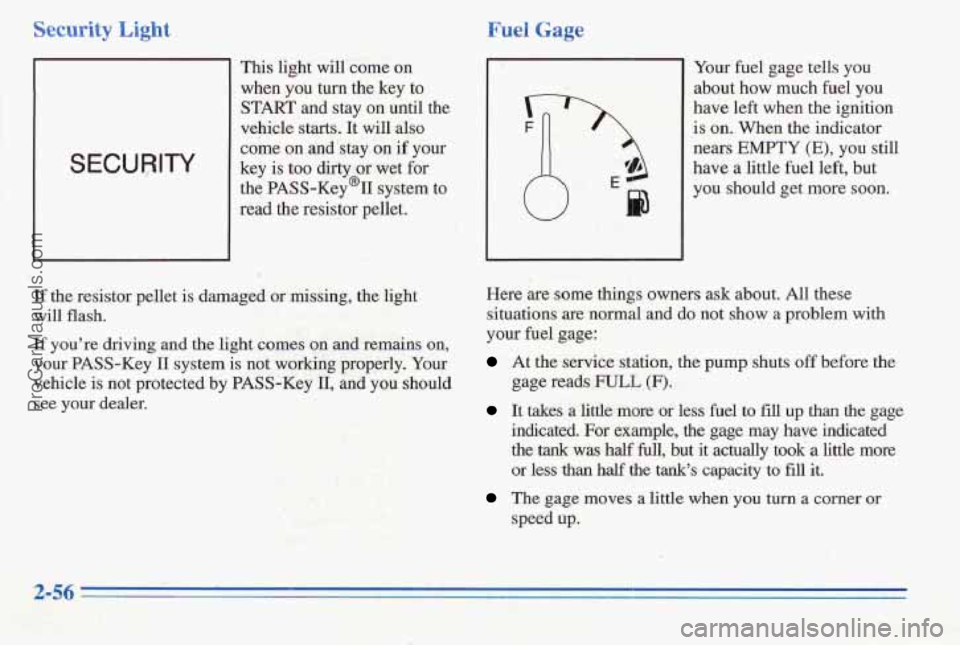
Security Light Fuel Gage
SECUPITY
This light will come on
when you turn the key to
START and stay on until the
vehicle starts. It
will also
come
on and’stay on if your
key
is too duty or wet for
the PAS$-Key@II system to
read
the resistor pellet.
If the resistor pellet is damaged or missing, the light
will flash.
If you’re driving
and the light comes on and remains on,
your PASS-Key 11 system is not working prop,erly. Your
vehicle
is not protected by PASS-Key II, and you should
see
your dealer. Your
fuel gage tells you
about how much fuel
you
have left when the ignition
is on.
When the indicator
nears
EMPTY (E), you still
have a little fuel left, but
you should get more soon.
Here are
some things owners ask about. All these
situations
are normal and do not show a problem with
your fuel gage:
At the service station, the pump shuts off before the
gage reads
FULL (F‘).
It takes a little more or less fuel to fill up than the gage
indicated. For example, the gage may have indicated
the tank was half full, but it actually took’ a little more
or less than half ,the tank’s capacity to fill it.
The gage moves a little when you turn a corner or
speed up.
2-56 -
ProCarManuals.com
Page 128 of 370

When you sit straight in your seat, the HUD image will
appear straight ahead near the front bumper.
When the ignition key is turned to RUN, all possible
HUD images will come on. Then the Head-Up Display
will operate normally.
NOTICE: ,
Although the HUD'image appears to be near the
front of the vehicle,
do not use it as a parking aid.
The HUD was not designed for that purpose. If you
try to use it that way, such as in a parking lot, you
may misjudge distance
and run into something.
To adjust the HUD so you can see it properly:
1.
2.
3.
4.
Start your engine and turn the HUD dial all the way up.
When the headlamps are off, the HUD image will
0 When the headlamps are on, the HUD image
Adjust your seat, if necessary, to a
comfortable position.
Press the top of the
IMAGE switch until the HUD
image stops moving. Then press the bottom
of the
switch until the image
is as low as possible, but in
full view.
Turn the HUD dial down until the HUD image
is no
brighter than necessary.
To turn the HUD off, turn
the HUD dial all the way down.
be
at a preset daytime brightness.
brightness is controlled by the dimmer control.
If the sun comes out, it becomes cloudy, or if you turn
on your headlamps, you may need to adjust the
HUD
brightness again. Polarizing sunglasses could make the
HUD image harder to see.
ProCarManuals.com
Page 157 of 370
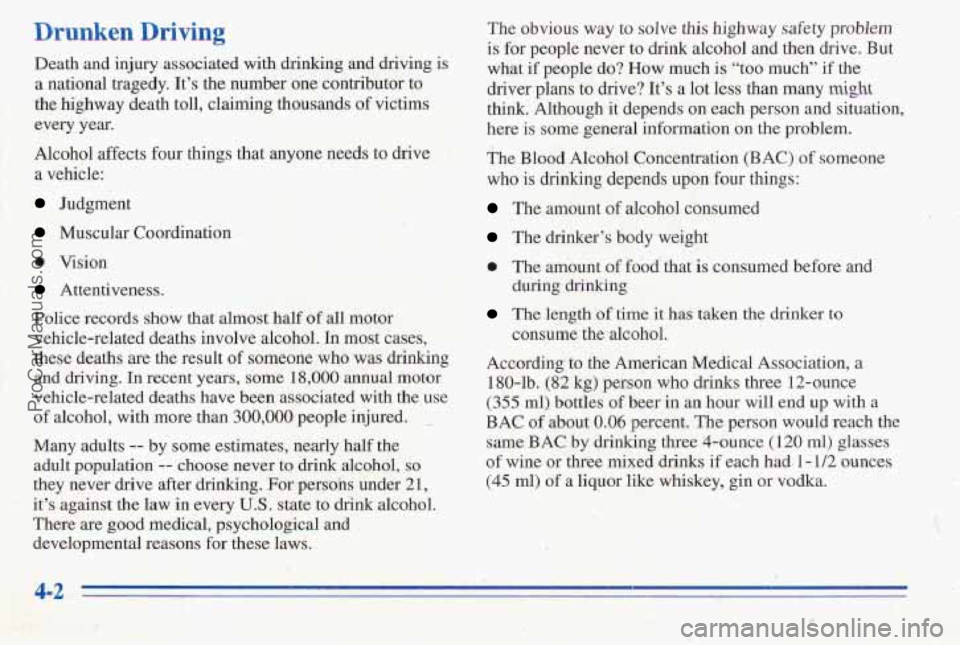
Drunken Driving
Death and injury associated, with drinking and driving is
a national tragedy. It,s the number one contributor to
the highway death toll, claiming thous&ds of victims
every year.
Alcohol affects four things that anyone needs to
drive
a vehcle:
Judgment
Muscular Coordination
0 Vision
Attentiveness.
Police records
‘show that almost half of all motor
vehicle-related deaths involve alcohol.
In most cases,
these deaths are the result of someone wh-o was drinking
and driving.
In recent years, some 18,000 annual motor
vehicle-related deaths have been associated with the use
of alcohol; with more than
30i),OOO people injured. __
Many adults -- by some estimates, nearly half the
adult population
-- ‘choose never to dririk alcohal, so
they never drive after drinking. Fot ,persons under 21 ,.
it’s against the law in every U.S. state to dfink alcohol.
There are
good medical, psychological and
lopmental reasons for these laws. The obvious
way to solve
this highway safety problem
is for people never to drink alcohol and then drive. But
what if people do? How much is
“too much” if the
driver plans to drive? It’s
a lot l&s than many might
think. Although it depends on each .person and situation,
here is some general information on the problem.
The Blood Alcohol Concentration (BAC).of someone
who is drinking depends upon four things:
The amount of alcohol consumed
The drinker’s body weight
0 The amount of food that is consumed before and
during drinking
The length of time it has taken the drinker to
consume the-alc’ohol:
According to the American Medical Association, a
180-lb.
(82 kg) person who drinks three 12-ounce
(355 ml) bottles of beer in an hour will end up with a
BAC
of about 0.06 percent. The person would reach the
same
BAC by drinking three 4-ounce (120 ml) glasses
of wine or three mixed drinks if each had.
1 - 1/2 ounces
(45 ml) of a liquor like whiskey, gin or vodka.
ProCarManuals.com
Page 194 of 370
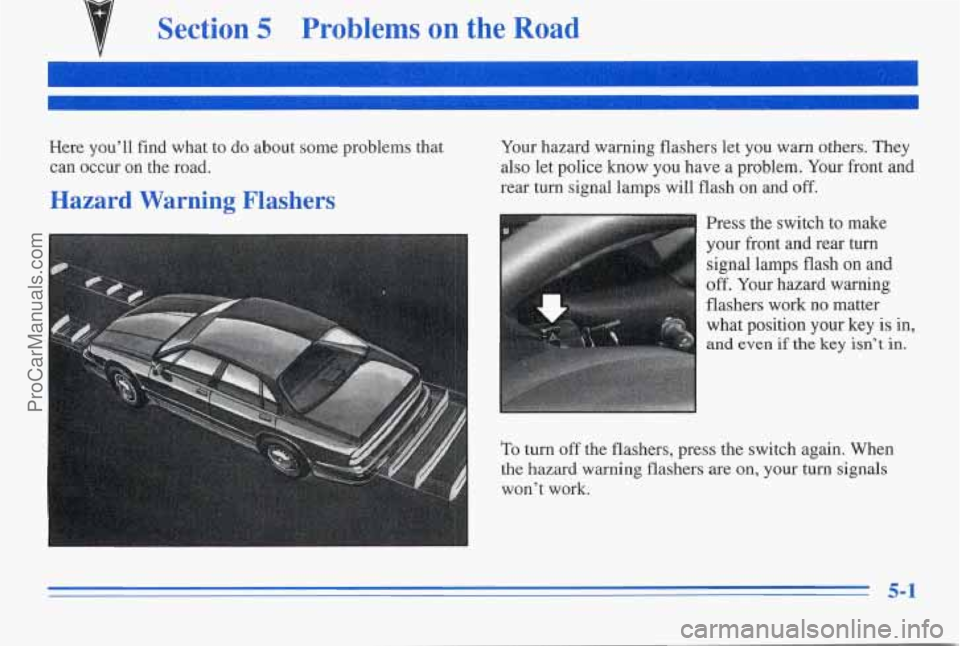
Section 5 Problems on the Road
Here you’ll find what to do about some problems that
can occur on the road.
Hazard Warning Flashers
Your hazard warning flashers let you warn others. They
also let police know you have a problem. Your front and
rear turn signal lamps will flash
on and off.
Press the switch to make
your front and rear turn
signal lamps flash on and
off. Your hazard warning
flashers work no matter
what position your key
is in,
and even if the key isn’t in.
’To turn off the flashers, press the switch again. When
the hazard warning flashers
are on, your turn signals
won’t work.
5-1
ProCarManuals.com
Page 340 of 370
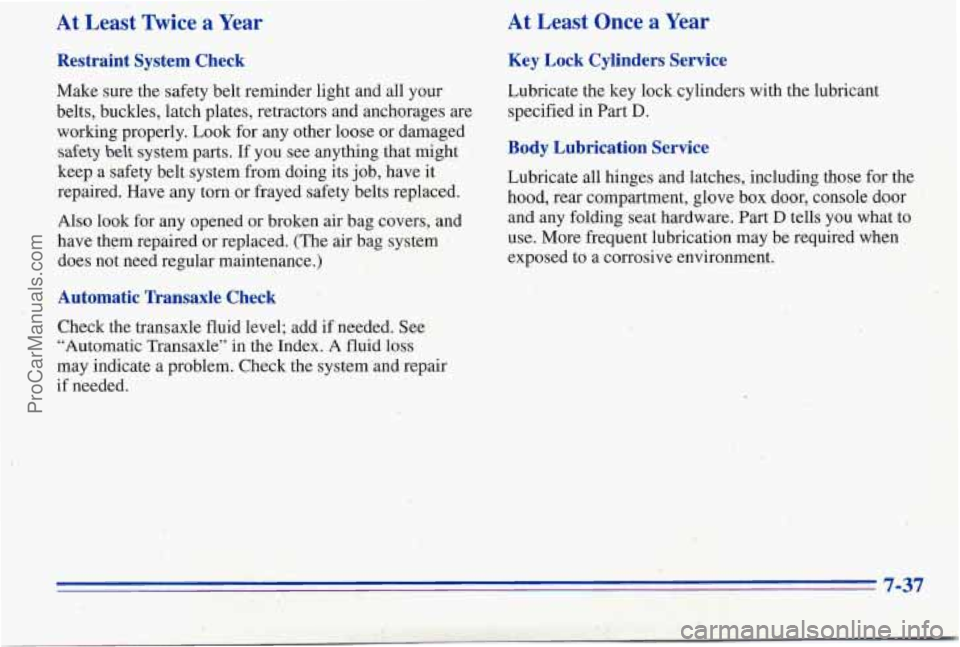
At Least Twice a Year
Restraint System Check
Make sure the safety belt reminder light and all your
belts, buckles, latch plates, retractors and anchorages are
working properly. Look for any other loose or damaged
safety belt system parts. If you see anything that might
keep a safety belt.system from doing its job, have it
repaired. Have any torn
or frayed safety belts replaced.
Also look for any opened or broken
air bag covers, and
have them repaired or replaced. (The air bag system
does not need regular maintenance.)
Automatic Transaxle Check
Check the transaxle fluid level; add if needed. See
“Automatic Transaxle” in the Index. A fluid
loss
may indicate a problem. Check the system and repair
if needed.
At Least Once a Year
Key Lock Cylinders Service
Lubricate the key lock cylinders with the lubricant
specified in
Part D.
Body Lubrication Service
Lubricate all hinges and latches, including those for the
hood, rear compartment, glove box door, console door
and any folding seat hardware.
Part D tells you what to
use. More frequent lubrication may be required when
exposed to
a corrosive environment.
ProCarManuals.com
Page 341 of 370
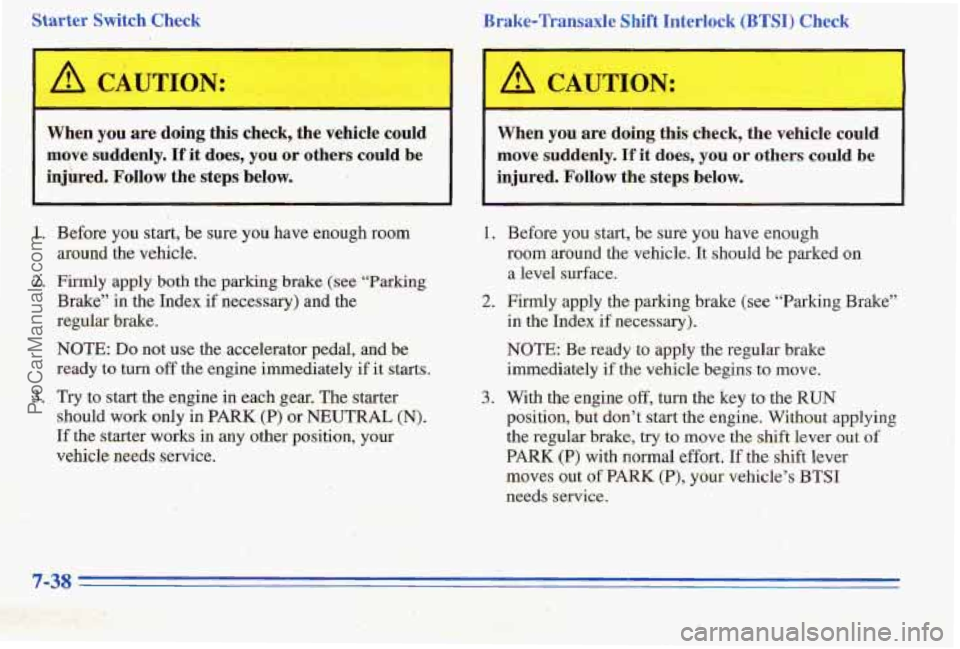
Starter Switch Check
I 4 CAUTION:
When you are doing this check, the vehicle could
move suddenly.
If it does, you or’ others could be
injbed.
Follow the steps below. Brake-Transaxle
Shift Interlock (BTSI) Check
..
i
When you are doing this check, the vehicle could
move suddenly. If it does, you or others could
be
injured. Follow the steps below.
1. Before you start, be sure you have enough room
around the vehicle.
2. Firmly apply both tl~e parking brake (see “Parking
Brake” in
the Index if necessary) and the
regular brake.
NOTE: Do not use the accelerator pedal, and be
ready ‘to turn off the engine immediately if it starts.
3. Try to start the engine in each gear, The starter
should work only
in PARK (P) or NEUTRAL (N).
If the starter works in any other position, I’; 7’* yo?-, c.. C.. .
vehicle needs service. . &;,,*;.$:+~c~: .i. .yr i e?- .- ’ ‘?- ‘e:,> ._ ’.( .
1. Before you start, be sure you have enough
room around
the vehicle. It should be parked on
a level surface.
2. Firmly apply the parking brake (see “Parking Brake”
in the Index if necessary).
NOTE: Be ready to apply the regular brake
immediately if the vehicle begins
to move.
3. With the engine off, turn the key to the RUN ‘4. ’* . .I. ,%
position, but don’t start the engine. Without applying
the regular brake,
try to move the shift lever out of
PARK (P) with normal effort. If the shift lever
moves out
of PARK (P), your vehicle’s BTSI
7-38
ProCarManuals.com
Page 342 of 370
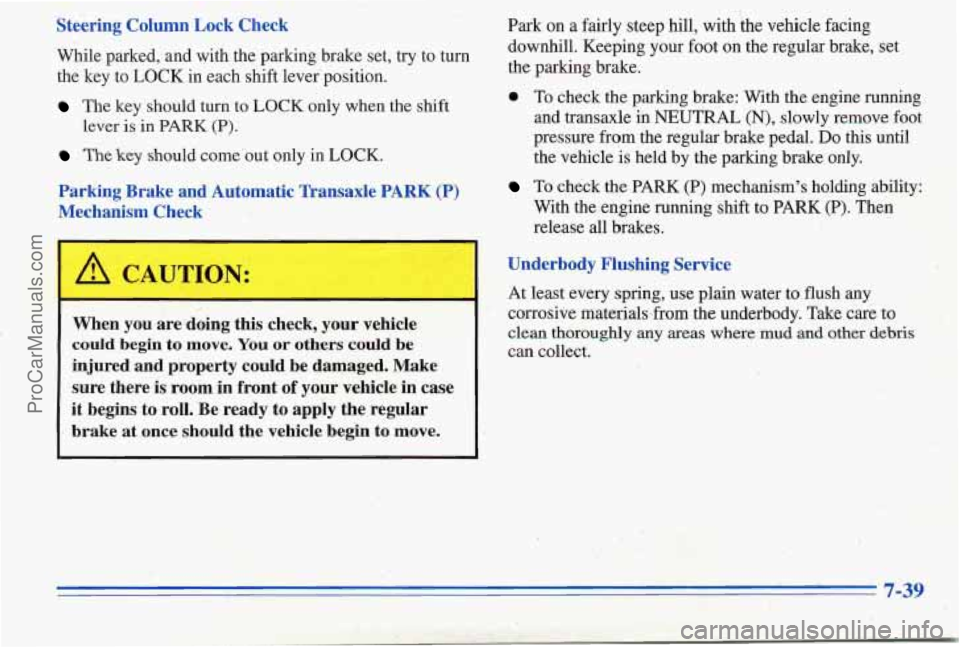
Steering Column Lock Check
While parked, and with the parking brake set, try to turn
the key to
LOCK in each shift lever position.
The key should turn to LOCK only when the shift
lever is
in PARK (P).
.. .II . The key should come’out only in LOCK. - _.,.‘I. .. .= q-.- yy;’:. ~, ; , ’
’: .i -.-a: r. &+parking .- . Brake and Automatic Transaxle PARK (P)
Mechanism Check - I
~. A CAUTION:
- ...LS* ’-?, .9-- 1% ZJ,$ -- I_ -: When you are doing this check, your vehicle
c , .: * injured and property could be damaged. Make
! r ,: . .-“I - could begin to move. You or others could be
sure there is room in front of your vehicle in case
it begins to roll. Be ready to apply the regular
brake
at once should the vehicle begin to move.
Park on a fairly steep hill, with the vehicle facing
downhill. Keeping your foot on the regular brake, set
the parking brake.
0 To check the parking brake: With the engine running
and transaxle in
NEUTRAL (N), slowly remove foot
pressure from the regular brake pedal.
Do this until
the vehicle
is held by the parking brake only.
To check the PARK (P) mechanism’s holding ability:
With the engine running shift to
PARK (P). Then
release all brakes.
Underbody Flushing Service
At least every spring, use plain,water to flush any
corrosive materials.from the underbody. Take care to
clean thoroughly any areas where mud and other
debris
can collect.
. .,, . .
7-39
ProCarManuals.com
Page 344 of 370
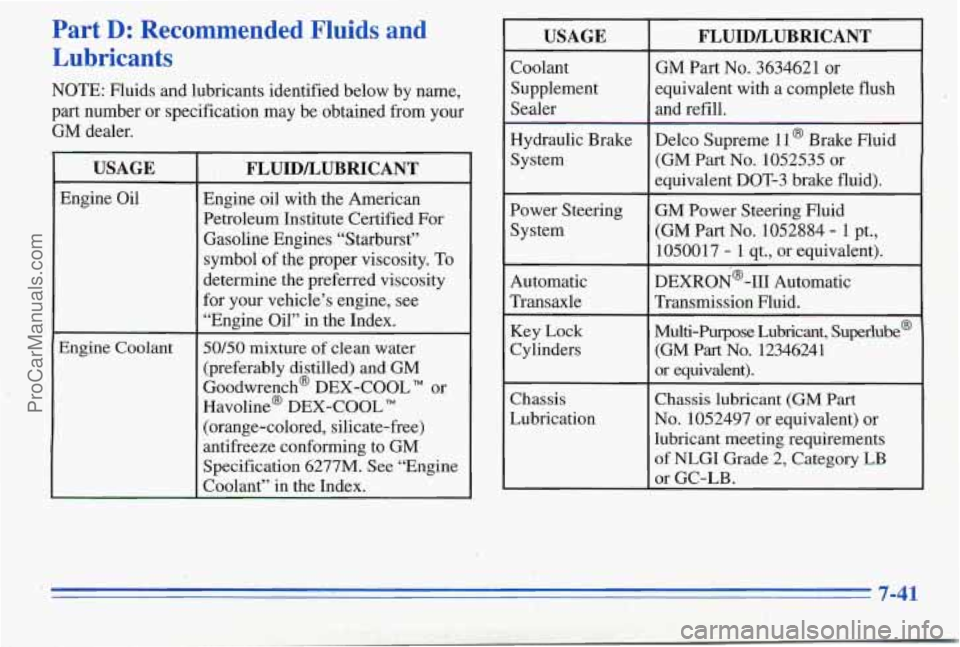
I
Part D: Recommended Fluids and
Lubricants
NOTE: Fluids and lubricants identified below by name,
part number or specification may be obtained from your
GM dealer.
USAGE
Engine Oil
Engine Coolant
FLUIDLUBRICANT
Engine oil with the American
Petroleum Institute Certified
For
Gasoline Engines “Starburst”
symbol of the proper viscosity.
To
determine the preferred viscosity
for your vehicle’s engine, see
“Engine Oil” in the Index.
50/50 mixture of clean water
(preferably distilled) and GM
Goodwrench@ DEX-COOL
TM or
Havoline@ DEX-COOL TM
(orange-colored, silicate-free)
antifreeze conforming to GM
Specification
6277M. See “Engine
Coolant” in the Index.
USAGE
Coolant
Supplement
Sealer
Hydraulic Brake System
Power Steering System
Automatic
Transaxle Key Lock
Cylinders
Chassis
Lubrication
FLUIDLUBRICANT
GM Part No. 3634621 or
equivalent with a complete flush
and refill.
Delco Supreme 11
@I Brake.Fluid
(GM Part No. 1052535 or
equivalent DOT-3 brake fluid).
GM Power Steering Fluid
10500 17 - 1 qt., or equivalent).
DEXRON@-III Automatic
Transmission Fluid.
Multi-Purpose Lubricant, Superlube’
(GM Part No. 12346241
or equivalent).
Chassis lubricant (GM Part
No. 1052497 or equivalent) or
lubricant meeting requirements
of NLGI Grade 2, Category LB
(GM
Part NO. 1052884
- 1 Pt.,
or GC-LB.
ProCarManuals.com